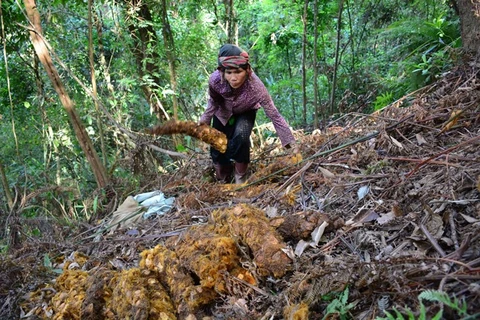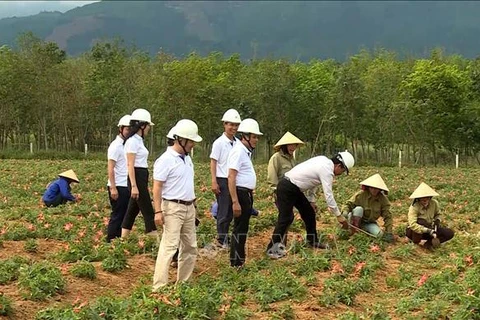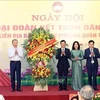Quang Nam (VNS/VNA) - Growing medicinal plants has helped tackle hunger and poverty for ethnic minority people in the central province of Quang Nam’s Tay Giang district, according to Nong Thon Ngay Nay (Countryside Today) newspaper.
According to Tran Van Ta, head of the district’s agriculture and rural development department, 90 percent of the mountainous district’s population are ethnic minorities who live on agricultural production with unstable incomes.
However, in recent years, thanks to the expansion of medicinal plant growing, hundreds of poor ethnic minority households have escaped from poverty, Ta told the paper.
The main medicinal plants grown in the district are 'dang sam' (poor man's gingseng) and 'ba kich' (Indian mulberry), he said.
“Growing the medicinal plants was a sound economic development model which was suitable with the district’s climate and soil characteristics”, Ta said.
“Growing medicinal plants has not only helped ethnic minority people get out of poverty but also brought them stable incomes. It was truly a breakthrough of the district”, he said.
Many households now earn 120-150 million VND (5,000 – 6,400 USD) per year.
Alang Lo, one of the ethnic minority people who has succeeded in the business in Achoong Hamlet told the paper: “Previously, my family planted keo (acacia) trees which did not bring high income."
“With the assistance of the district’s authority, I shifted into growing 'dang sam' plants”, he said.
The plants were easy to nurture and could be harvested after two years, he said.
The 5ha of medicinal plants brought his family annual income of 120-150 million VND (5,000-6,400 USD) which helped them escape hunger and poverty, and covered his children’s education fees.
Another farmer who earned money from 'ba kich' is Co Lau Thai Ngoc in Po r’ning Hamlet.
Along with growing acacia trees and raising livestock, his family cultivates 3ha of the medicinal plants, bringing 150-200 million VND (6,400-8,600 USD) per year.
Le Hoang Linh, Vice Chairman of the Tay Giang District People's Committee, said the district has 941ha of the two medicinal plants grown by more than 1,000 households in Ch’om, Gari and Lang communes.
In recent years year, Quang Nam province has carried out several policies on developing medicinal plants such as the provincial People’s Committee’s resolution on planning and developing medicinal plants in Quang Nam in 2018-2025.
“The plan of preserving and developing has helped Tay Giang district develop its economy”, said Linh.
“The number of poor households dropped to 43 percent this year from 84 percent in 2003”, he added.
Tay Giang plans to expand medicinal plant growing and to encourage co-operatives and pharmaceutical companies to join with local people to form production chains to raise the economic value of the plants, he added.
At present, the district has two products of 'ba kich' and 'dang sam' medicinal wines which have been recognised with the province’s One Commune One Product (OCOP) title./.
According to Tran Van Ta, head of the district’s agriculture and rural development department, 90 percent of the mountainous district’s population are ethnic minorities who live on agricultural production with unstable incomes.
However, in recent years, thanks to the expansion of medicinal plant growing, hundreds of poor ethnic minority households have escaped from poverty, Ta told the paper.
The main medicinal plants grown in the district are 'dang sam' (poor man's gingseng) and 'ba kich' (Indian mulberry), he said.
“Growing the medicinal plants was a sound economic development model which was suitable with the district’s climate and soil characteristics”, Ta said.
“Growing medicinal plants has not only helped ethnic minority people get out of poverty but also brought them stable incomes. It was truly a breakthrough of the district”, he said.
Many households now earn 120-150 million VND (5,000 – 6,400 USD) per year.
Alang Lo, one of the ethnic minority people who has succeeded in the business in Achoong Hamlet told the paper: “Previously, my family planted keo (acacia) trees which did not bring high income."
“With the assistance of the district’s authority, I shifted into growing 'dang sam' plants”, he said.
The plants were easy to nurture and could be harvested after two years, he said.
The 5ha of medicinal plants brought his family annual income of 120-150 million VND (5,000-6,400 USD) which helped them escape hunger and poverty, and covered his children’s education fees.
Another farmer who earned money from 'ba kich' is Co Lau Thai Ngoc in Po r’ning Hamlet.
Along with growing acacia trees and raising livestock, his family cultivates 3ha of the medicinal plants, bringing 150-200 million VND (6,400-8,600 USD) per year.
Le Hoang Linh, Vice Chairman of the Tay Giang District People's Committee, said the district has 941ha of the two medicinal plants grown by more than 1,000 households in Ch’om, Gari and Lang communes.
In recent years year, Quang Nam province has carried out several policies on developing medicinal plants such as the provincial People’s Committee’s resolution on planning and developing medicinal plants in Quang Nam in 2018-2025.
“The plan of preserving and developing has helped Tay Giang district develop its economy”, said Linh.
“The number of poor households dropped to 43 percent this year from 84 percent in 2003”, he added.
Tay Giang plans to expand medicinal plant growing and to encourage co-operatives and pharmaceutical companies to join with local people to form production chains to raise the economic value of the plants, he added.
At present, the district has two products of 'ba kich' and 'dang sam' medicinal wines which have been recognised with the province’s One Commune One Product (OCOP) title./.
VNA























